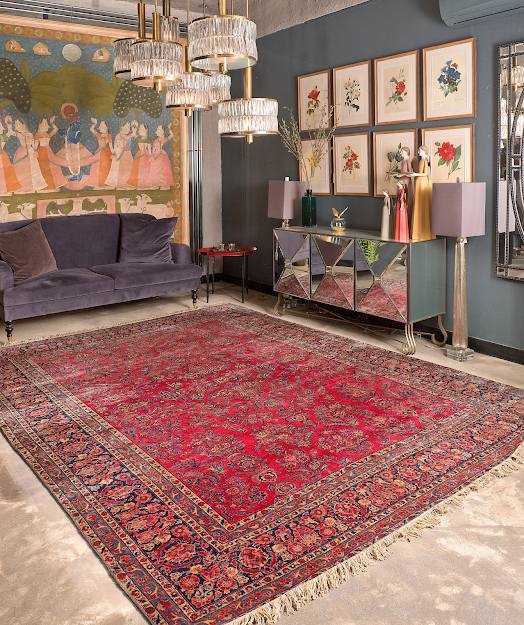From Tradition to Trend: How Persian Rugs Are Redefining Modern Home Decor
Owning a Persian Rugs is not just about acquiring a beautiful floor covering; it's an investment in a piece of art with cultural significance and enduring value. In this exploration, we delve into the factors that contribute to the value of Persian rugs, from the craftsmanship and materials to the cultural heritage that makes each rug a timeless treasure.
Handcrafted Masterpieces
One of the primary factors that contribute to the value of Persian rugs is the meticulous handcrafting process. Each rug is a labor-intensive creation, with skilled artisans dedicating months or even years to complete a single piece. The art of hand-knotting, passed down through generations, results in a rug that is not just a functional floor covering but a true work of art. The precision, skill, and artistry involved in the handcrafting process add an intrinsic value that distinguishes Persian rugs from machine-made alternatives.
Intricate Designs and Cultural Significance
The intricate designs of Persian rugs, often featuring elaborate patterns, motifs, and symbols, contribute to their cultural significance and value. These designs are not arbitrary; they carry deep cultural meaning and often reflect the traditions and beliefs of the region where the rug is crafted. The incorporation of symbolic motifs, such as the tree of life or medallions, adds layers of storytelling to the rug. The cultural richness embedded in these designs enhances the overall value of Persian rugs as tangible expressions of heritage.
Materials of Exceptional Quality
The value of Persian rugs is also influenced by the exceptional quality of materials used in their construction. Wool is the most common material, prized for its durability, natural luster, and softness underfoot. In some cases, silk is incorporated into the design, adding a luxurious sheen and enhancing the intricacy of patterns. The use of high-quality materials contributes to the rug's longevity, ensuring that it retains its beauty and structure over the years. The value associated with these premium materials adds to the overall worth of Persian rugs.
Regional Variation and Rarity
The region in which a Persian rug is crafted plays a significant role in its value. Different regions within Iran have distinct styles and techniques, resulting in a diverse range of Persian rugs. For example, rugs from Kashan are known for their intricate medallion designs, while those from Tabriz boast a variety of patterns and colors. The regional variation adds to the rarity of specific styles, influencing the value of rugs from certain regions. Limited production of rare designs contributes to the exclusivity and desirability of Persian rugs.
Age and Historical Significance
The age of a Persian rug can greatly impact its value, with antique and vintage rugs often commanding higher prices. Older rugs may exhibit a patina that adds character and authenticity to their appearance. Additionally, rugs with historical significance, such as those crafted during specific periods or under the influence of renowned master weavers, hold a unique value. The historical context and age contribute to the rug's narrative, making it a sought-after piece for collectors and enthusiasts.
Craftsmanship and Knot Density
The level of craftsmanship and knot density in a Persian rug is a key determinant of its value. Hand-knotted rugs with a higher knot density generally have more intricate designs and a finer texture, showcasing the skill of the artisan. The time and effort invested in achieving a higher knot density contribute to the overall value of the rug. The craftsmanship is often measured in knots per square inch, with rugs featuring a higher knot count considered more valuable due to the level of detail and precision.
Condition and Preservation
The condition of a Persian rug significantly influences its value. Rugs that have been well-preserved, with minimal signs of wear, fading, or damage, are generally more valuable. Proper care, regular maintenance, and professional cleaning contribute to the longevity and condition of the rug. Antique rugs in pristine condition, with vibrant colors and minimal wear, are particularly sought after by collectors. The care taken to preserve the rug over the years adds to its value as a well-maintained and cherished piece.
Market Demand and Trends
Market demand and trends within the rug industry also play a role in determining the value of Persian rugs. Styles that align with current design trends or appeal to collectors' preferences may experience increased demand, influencing their market value. Additionally, factors such as the rarity of certain designs, the reputation of specific weavers or workshops, and the overall popularity of Persian rugs contribute to fluctuations in market value. Understanding market dynamics can provide insights into the potential appreciation of a Persian rug over time.
Appraisal by Experts
For a comprehensive understanding of a Persian rug's value, seeking appraisal by experts in the field is advisable. Professional appraisers with expertise in Persian rugs can assess various factors, including the rug's age, condition, craftsmanship, materials, and historical significance. Their appraisal provides an informed estimate of the rug's value, which can be valuable for insurance purposes, resale considerations, or simply understanding the worth of a cherished family heirloom.
In conclusion, the value of Persian Rugs is multifaceted, encompassing the craftsmanship, intricate designs, exceptional materials, regional variation, rarity, age, historical significance, knot density, condition, market demand, trends, and expert appraisal. As investments of a lifetime, Persian rugs hold not only aesthetic beauty but also cultural and historical significance, making them prized possessions that appreciate in value over the years.




Comments
Post a Comment